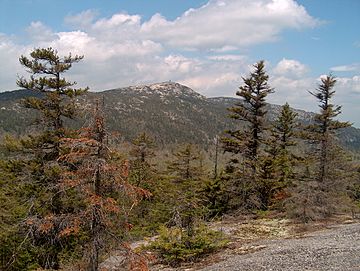Mount Cardigan facts for kids
Quick facts for kids Mount Cardigan |
|
|---|---|

Mount Cardigan from the south
|
|
| Highest point | |
| Elevation | 3,155 ft (962 m) |
| Prominence | 1,925 ft (587 m) |
| Geography | |
| Location | Orange / Alexandria, New Hampshire, U.S. |
| Topo map | USGS Mount Cardigan |
| Climbing | |
| Easiest route | West Ridge Trail |
Mount Cardigan is a famous mountain in western New Hampshire, U.S.. It stands tall in the towns of Orange and Alexandria. Even though its top is only about 3,155 feet (962 meters) above sea level, it feels much higher. This is because a large part of the mountain's summit is bare rock and low-growing plants.
Long ago, in 1855, big forest fires burned away most of the trees near the top. This is why you see so much open granite rock today.
Contents
Exploring Mount Cardigan
Mount Cardigan is a popular spot for outdoor adventures. It's part of the large Cardigan Mountain State Park, which covers about 5,655 acres (22.88 square kilometers). This park helps protect the mountain's natural beauty.
Hiking and Trails
Many people love to hike on Mount Cardigan. The mountain has many trails, including the West Ridge Trail, which is known as the easiest way to reach the top. From the summit, hikers get amazing views of the surrounding area.
Skiing History
On the east side of the mountain, you can find a network of alpine ski trails. These trails are still used today! They were first built with help from the Civilian Conservation Corps. This group worked on many projects across the U.S. during the 1930s.
The Cardigan Lodge
At the base of the mountain, on its east side, is the Cardigan Lodge. The Appalachian Mountain Club has run this lodge since 1934. It's a great place for hikers to stay before or after their trips up the mountain. Many schools from New England bring students here for field trips in the spring and autumn. It's also a favorite spot for Boy Scout troops to visit.
How Mount Cardigan Was Formed
The rocks of Mount Cardigan are very old. They were formed millions of years ago. The mountain's western side is made of a type of rock called the Littleton Formation. The very top and eastern side are made of Kinsman Granodiorite. These rocks were shaped by powerful forces over time.
Water Flowing from the Mountain
Mount Cardigan is like a giant natural divider for water. Rain and snow that fall on the western side flow towards the Connecticut River. This water eventually reaches Long Island Sound.
Water falling on the southern and eastern sides of the mountain flows into different rivers. These rivers eventually join the Merrimack River, which then flows into the Gulf of Maine. So, water from Mount Cardigan travels far and wide!


